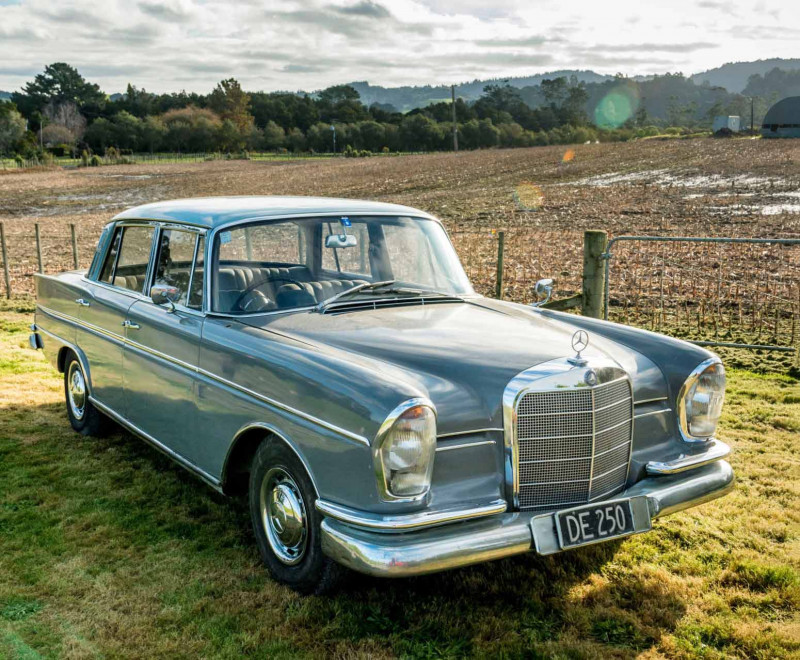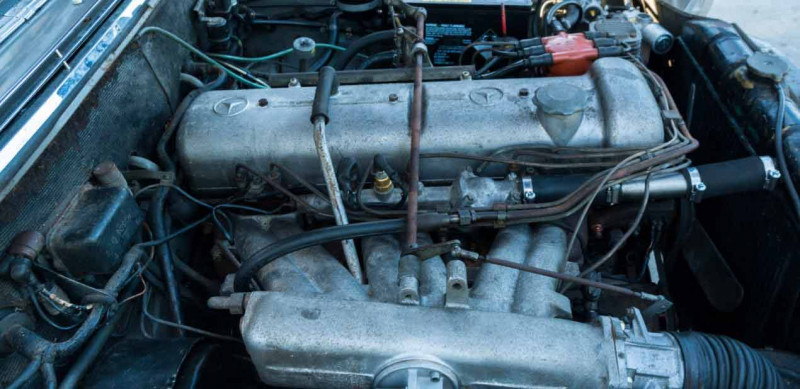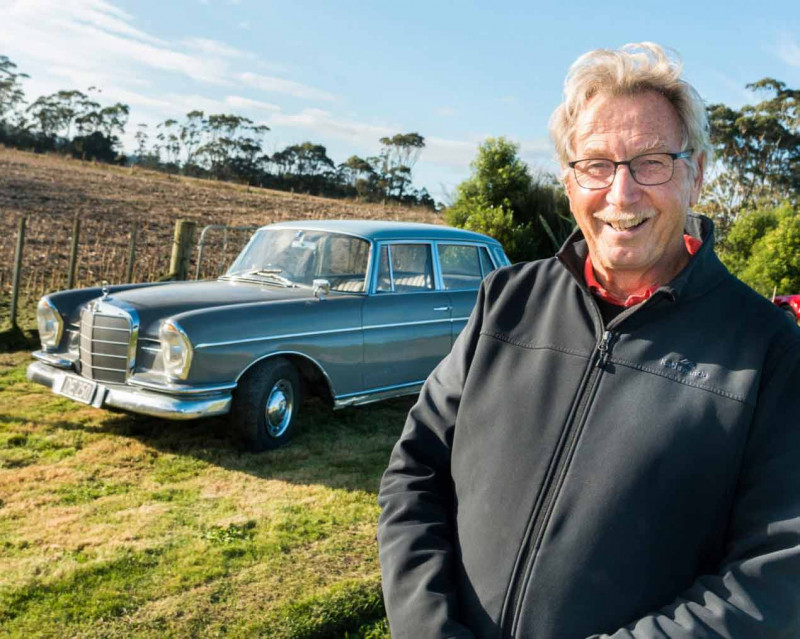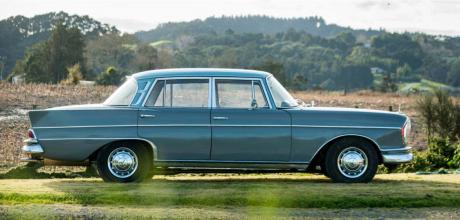1965 Mercedes-Benz 300SE LWB W112
The W111 and W112 Mercedes-Benz S-class helped shape the ’60s and established the firm’s legacy as a global luxury brand. By Ian Parkes.
Feature Car: Double feature: 1965 Mercedes-Benz 300SE
THE FABLED ‘FINNY’ Mercedes 300SE
SETTING THE STANDARD
For people of a certain vintage, the big Heckflosse Mercedes-Benz will likely recall ’60s and ’70s TV dramas and films. No European-based crime drama car chase worth its salt would be complete without the hero having to evade a black Heckflosse or two full of black-clad baddies armed to the teeth with evil intent being flung around the streets, body rolling, tyres screeching.

Some, if not many, would come to a crunching end, no doubt as much to the satisfaction of Mercedes sales department as the viewers punting for the hero, but it always seemed a terrible waste. Mercedes- Benzes were rare and precious things in this part of the world. Witnessing them being wasted like that was a bit confronting — like seeing The Who smash up their instruments. Visiting Europe later and seeing that, over there, Mercedes were so common that they were used as taxis was some consolation. But the W112 was special. I remember riding one as a young child in the UK, which belonged to our one rich relative. I think it had a white steering wheel, almost certainly whitewall tyres, but that vertical instrument binnacle with the red strip speedo left an indelible impression. It looked to be straight out of a rocket.

The other firm memory was of the space inside the car, accentuated by its four-square, large glass greenhouse. Space certainly seemed to be much more generous than in the Humber Super Snipe my uncle replaced it with. The new W111 car, introduced in 1959, was 4880mm long and 1845mm wide, considerably bigger than the W180 ‘Ponton’ model it replaced, which was 4715mm long and 1740mm wide.
At launch, all of the W111 models shared the 2195cc M127 straight-six engine. The 220B was an en try-level version with little chrome trim, simple hub caps, and basic interior trim.
The top of the range 220SE featured Bosch fuel injection producing 120hp (89kW) at 4800rpm and a 0–100kph (62mph) time of 14 seconds.
RALLYING CRY
The fundamental car also represented a technological step forward at the time, and the W111 was the car that helped establish the global reputation of the marque. One of the events that caught people’s attention was its performance in the 1960 Monte Carlo Rally.
One year after the W111 sedan was launched, it entered and won the rally, in fact taking first, second, and third place. Walter Schock and Rolf Moll took the honours. The highest-placed other car was a Sunbeam Rapier, which helps place the car in the context of its time.

Mercedes already had a reputation pre-war and in the immediate postwar years as a luxury car maker, but the development of the monocoque Ponton models in the ’50s gave them a middle-class presence and stronger revenues. Mercedes began design of its replacement in 1956, and engineer Karl Wilfert’s focus on safety resulted in this car being the first with designed crumple zones front and rear. He was also the advocate for the reverse curve in the famous Pagoda Mercedes roadsters.
The large square grille and bluff front of the new car were much more imposing than the softer curves of the Pontons, but that only underscored the brand’s reputation for solidity. While the body has more creases than many later designs, the W111 series, which also included four-cylinder models dubbed W110, established the key visual cues unique to Mercedes for generations to come.
While they were unique to this model series, the vestigial fins also squared off the rear. By the way, ‘Heckflosse’ is German for ‘fintail’, which is the nickname these W111 and W112 cars acquired around the world, for this feature added to appeal to American eyes. The nickname was never an official designation. You might also have seen versions of these cars with twin round headlights, mounted vertically. They were for the American market, where the standard lights weren’t legal at the time. While the fins might look frivolous, they were actually practical. It helped create an enormous boot, and they were clearly visible through the large rear window. That provided a handy reference when reversing, echoing the reversing stalks in the rear quarters of the S600 on the preceding pages. During its ten-year run be tween 1959 and 1968, a total of 337,803 W111s were built.
STOP GAP
The 300SE was introduced in 1961 to fill the gap between the discontinued Adenaur and the car that was due to replace it, making the W112 the top-of-the-range car at that time — although, like the S600, there was a long-wheelbase version for those who preferred to sit in the back. And as we ignored the AMG version of the later car in that story, we’ll also ignore that W100 600 Grosse, or Grand Mercedes, which arrived in 1964 and ran through to 1981.
Also like the S600, the 300SE car cost almost twice the price of more basic versions, but in this case it was double the price of the top-of-the-line W111 220SE. The W112 is primarily distinguished from the W111 that shared the same bodyshell by its air suspension, although the engine was also unique to the W112. The 300SE was built in much smaller numbers than the W111, totalling just 6748 W112s in standard and long wheelbase form.
The W112 used the three-litre M189 straight six, which had the same alloy block as used in the M198 engine in the company’s legendary and now stratospherically expensive 300SL Gullwing cars. This M189 engine from the Adenauer produced 160hp (170hp after 1964) giving the car a top speed of 180kph (190kph after 1964). The E in the car’s 300SE designation engine stands for Einspritzung or fuel injection, again an advanced feature at the time.
The other noticeable and memorable feature of my uncle’s 300SE was the plushness of its ride. A look under the car confirmed that where you might expect to see coil springs there are large squashy doughnuts, mechanically inflated by a pump and condenser located in the corner of the engine bay.
Riding in this one the other day recalled those first impressions so clearly. The space and airiness is still noticeable, even though big cars are much more common now. That’s a consequence of modern cars rooflines’ flowing inwards much more dramatically to improve aerodynamics. It might also help explain why large square utes are taking the place of saloon cars in many suburban driveways. Perhaps people just want more headroom.
Most Mercedes-Benz suspensions are set up for higher average speeds on much smoother roads than you find in New Zealand, so they tend to feel firm, if not actually harsh, when driven here. Not this car. We only went for a short blast, but the ride over a gravel drive and out on country roads was delightfully plush. You’d swear the red strip speeding was indicating kph, but it was actually recording miles per hour. I’d say the ride was the equal of that in the 30-years later S600 we looked at in the previous pages. It was certainly not as quiet, but it wasn’t noisy, and the large airy glasshouse made the connection with the outside world seem logical and appropriate.
RIDING ON AIR
Mercedes didn’t invent air suspension. It had been in production on Tatra and Borgward cars and on aircraft and heavy trucks. However, the W112 had a clever variation in that the airbag was mounted on a cone. That means as load increases the bag is pressed further down the cone, increasing the pressure. It is in effect infinitely variable. It keeps the car at the chosen ride height regardless of load, and it stiffens under load when driven hard.
The compressor was needed to keep the bags filled, but it also meant the car’s ride height could be raised 50mm if needed.
The flagship saloon also sported wood trim on the dashboard and door cappings, which was less common in German cars than the British cars of the era.
Most also had leather trim, although this car was upholstered in Mercedes- Benz’ legendary breathable MB-Tex vinyl. It’s a tribute to its inventors that it remains intact and attractive to this day when the rest of this original condition car has a decent amount of patina on the paint, and too much on the woodwork.
Other standard luxury features included power steering and a four-speed automatic transmission. It didn’t have the fripperies slathered onto the newer car, but that trick air suspension is surely much more impressive than a list of toys.
Owner Harald Decker was a Mercedes fan from his student days in Germany when he bought a 180B Ponton that also sits in his garage today. He came to New Zealand in 1986 and established a landscaping business here. He knew the 300SE was the rare top-of-the-line car of its day so was immediately interested, a few years later, when this car came up for sale in Trade & Exchange. He’d only spotted one other 300SE in the intervening years. He loved the lines, but what appealed most, he said, apart from the car having Mercedes’ first air suspension, was the sheer indulgence in chrome. It exceeded anything Mercedes-Benz has done, except in the Grosse, before or since. The other models, especially the four-cylinder cars, had virtually no chrome, so it was a nice visual treat for those who like to spot the fine detail that distinguishes different models.
The 300SE had a detailed chrome air vent in the rear pillar but, not including the rings of chrome on the wheels, counting from top to bottom in that area the eye traverses no fewer than six strips of chrome, not including the window surrounds.
One of the first jobs he knew he had to do was recondition the suspension. Those rubber suspension bags don’t last forever, but all the parts were available and the whole system was rebuilt. He also fitted a new petrol tank, brake cylinders, and distributor cap, which was the most difficult part to find. The gearbox was also reconditioned.
TOP OF THE CLASS
While it is always a treat to see a car in genuine original unrestored condition — we get spoilt here at New Zealand Classic Car, often being invited to see fully restored motoring gems — it’s not like Harald doesn’t do that, too. Also in his garage is an absolutely pristine 190SL, which notched up the highest points score ever awarded at the Ellerslie Intermarque Concours d’Elegance — 571 out of a possible 590 — in 2018.
At the moment, he’s not sure if and to what point he will restore the 300SE, as he has several other Mercedes projects on the go. His garage includes other Ponton cars and even an old Adenauer saloon in heavily distressed condition.
He also has a very tidy 280SL Pagoda Mercedes, one of the most desirable models in the Mercedes back catalogue. Interestingly, Harald didn’t especially like them until he owned one. He is now a complete convert, saying it is an “amazing car”. That immediately prompted a question: How and why did he wind up owning one if he didn’t want one? “It was my mother’s,” he said, which makes Harald one of the very few people on the planet to have had a Pagoda Mercedes thrust upon them.
The car that gets driven the most in the family though is a W124 250D station wagon, which is still going strong at close to 550,000km. It is the newest car Harald and Vivian Decker own. Harald says they bought a later model a few months back, but it had the main gear selector on a steering column stalk and it was too easy to select reverse when trying to indicate a turn.
“Vivian didn’t like driving it, so we only had it two weeks,” he says.
TECHNICAL DATA 1965 Mercedes-Benz 300SE LWB W112
- Engine: Six-cylinder M189
- Capacity: 2996cc
- Bore/stroke: 85 x 88mm
- Valves: SOHC, two valves per-cylinder
- Compression Ratio: 8.7:1
- Fuel system: Bosch two plunger pump
- Max power: 160bhp (119.3kW) @ 5000rpm
- Max torque: 206.1Nm @ 4100rpm
- Transmission: Four-speed automatic
- Suspension F/R: Independent front and rear, with coil springs, single joint swing axle and air suspension
- Steering: Recirculating ball
- Brakes F/R: Servo assisted disc
- Dimensions
- Overall length: 4875mm
- Width: 1795mm
- Height: 1455mm
- Wheelbase: 2850mm
- Kerb weight: 1580kg
- Performance
- Max speed: 177kph
- 0-96kph: 10.7 seconds
Harald is one of very few people on the planet to have had a Pagoda Mercedes thrust upon him. Car comes complete with map of dealers in Europe. Air suspension system overhauled. All alloy fuel-injected six.
The W112 ‘s engine has the same alloy block used in the stratospherically expensive 300SL Gullwing
This car was upholstered in Mercedes-Benz legendary breathable MB-Tex vinyl. Chrome galore.


